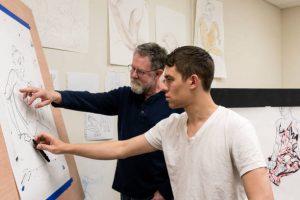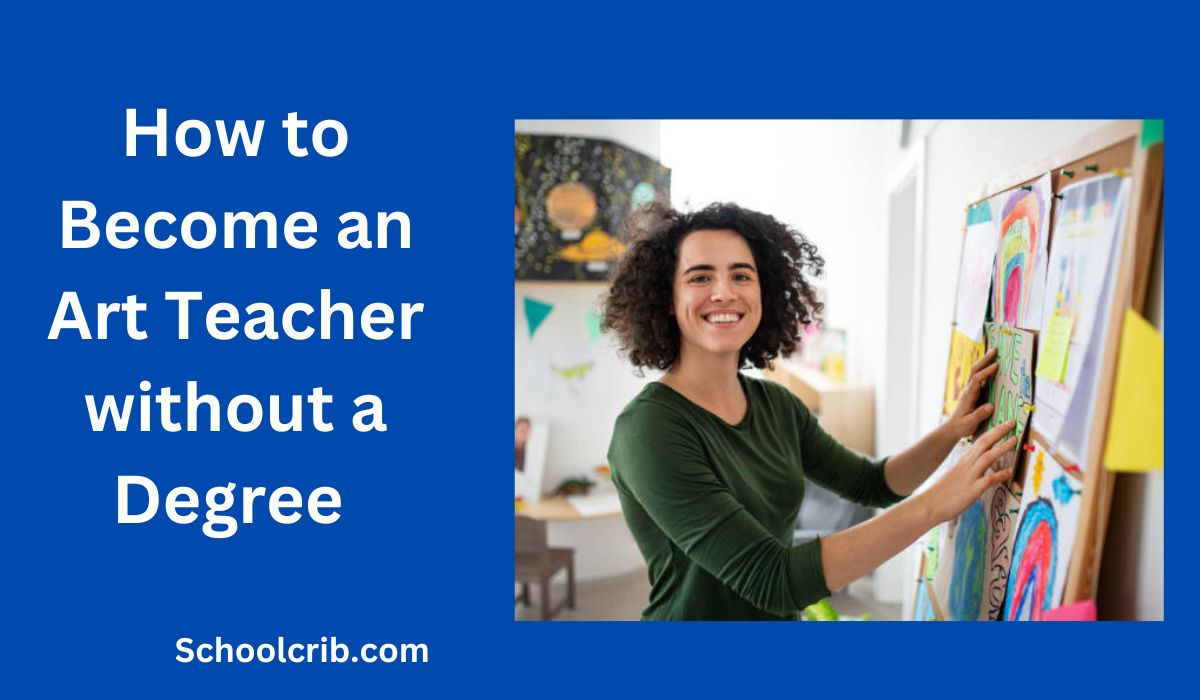If you are searching for how to become an art teacher without a degree, you are in the right place!
If you don’t have a degree but wish to become an art teacher, you may be wondering how possible this can be.
Well, becoming an art teacher without a degree can often be challenging but it’s not entirely impossible.
While a formal degree in art education is important to become an art teacher, there alternative paths you can explore if you’re really passionate about teaching art.
In this guide, we will look into how to become an art teacher without a degree as well as other vital things you need to know.
Ready? Let’s dive in!
Also Read: Do Hospitals Hire Associate Degree Nurses?
What Is an Art Teacher?

An art teacher is an educator who specializes in teaching visual arts to students of all ages.
They instruct in various art techniques, materials, and styles, fostering creativity and self-expression.
Art teachers create curriculum plans, encourage creativity, and provide constructive feedback on students’ work.
They also incorporate art history and cultural context into lessons, expose students to diverse art forms, and adapt teaching methods to individual needs.
These teachers manage classrooms, handle administrative tasks, and may organize art exhibitions and community programs.
They work in schools, colleges, studios, and community centers, leaving a lasting impact on students’ artistic abilities and creative thinking.
Overall, art teachers play a vital role in nurturing artistic talent and appreciation.
Recommended: What Can You Do with a Culinary Degree?
How to Become an Art Teacher without a Degree

Becoming an art teacher without a degree can be challenging, as many educational institutions and employers typically require a bachelor’s degree in art education or a related field for teaching positions.
However, it’s not impossible, and there are alternative pathways you can explore:
1. Teach in Informal Settings
You can teach art in informal settings such as community centers, art studios, after-school programs, or workshops.
These positions may not require a formal degree but often value practical experience and expertise in a specific art form.
2. Become a Teaching Assistant
Consider becoming a teaching assistant in an art classroom.
This role can provide you with hands-on experience and allow you to learn from experienced educators while you work toward meeting educational requirements.
3. Online Art Instruction
You can offer art instruction online through platforms like YouTube, Skillshare, or Udemy.
Building a strong online presence and a following can help establish your credibility as an art teacher.
Also See: Can I Get an Associates Degree in High School?
4. Art Certification Programs
Some institutions and organizations offer art certification programs that don’t require a traditional degree.
These programs focus on developing your teaching skills and knowledge of art education principles.
5. Portfolio Development
Build an impressive portfolio showcasing your art skills and versatility in various mediums and styles.
A strong portfolio can help you gain recognition and credibility as an art instructor.
6. Continuing Education
Consider taking art education courses or workshops to enhance your teaching skills and stay updated on current trends and techniques in art education.
Also Read: What Jobs Can I Get with an Associate of Arts Degree?
7. Volunteer and Gain Experience
Volunteer at schools, community centers, or organizations that promote art education.
This practical experience can be valuable when seeking teaching opportunities.
8. Private Tutoring
Offer private art tutoring to individuals or small groups.
While this may not require a degree, it does demand expertise in your chosen art form and effective teaching methods.
9. Network
Attend art-related events, workshops, and conferences to network with professionals in the field.
Building connections can lead to teaching opportunities and collaborations.
10. Explore Alternative Education Paths
Some countries and regions have alternative certification routes or “teaching without a degree” programs.
Research the requirements and options available in your area.
While it’s possible to become an art teacher without a degree, keep in mind that having a degree in art education or a related field can significantly enhance your prospects and qualifications.
Pursuing higher education can provide you with a deeper understanding of teaching methodologies, child development, and educational theory, making you a more effective and competitive art teacher in formal educational settings.
Also See: What Can You Do with a Music Production Degree?
Required Skills for Art Teachers

To excel as an art teacher, there are certain essential skills you must possess.
Here are some of the required skills for art teachers:
1. Artistic Proficiency
To be an art teacher, you’ve got to be good at making art yourself.
Whether it’s painting, drawing, sculpture, or digital art, you should have a strong skill set and be able to produce quality artwork.
Your students will look up to you as a role model, so your artistry is key.
2. Teaching Skills
Teaching art isn’t just about creating art; it’s about effectively communicating your knowledge and techniques to others.
You need to explain concepts clearly, demonstrate various art methods, and give constructive feedback to students at different skill levels.
3. Adaptability
No two students are the same, and their learning styles can vary widely.
You must be adaptable in your teaching methods to accommodate these differences.
Some students might learn best through hands-on activities, while others thrive with more theoretical approaches.
Also Read: Can You Be a Dental Assistant without a Degree?
4. Patience
Art can be a trial-and-error process. Students will make mistakes and may get frustrated.
Your patience in guiding them through these challenges is invaluable.
A calm and encouraging demeanor can make a big difference.
5. Creativity
Fostering creativity is one of the primary goals of an art teacher.
You should inspire your students to explore new ideas, think outside the box, and develop their unique artistic voices.
6. Organization
Being organized is crucial.
From lesson planning to managing art supplies and maintaining a tidy classroom, staying organized helps everything run smoothly.
Recommended: What Can I Do with a Project Management Degree?
7. Art History and Cultural Knowledge
Understanding the history of art and the cultural contexts behind different art forms is vital.
It adds depth to your teaching and helps students appreciate the broader context of their artistic endeavors.
8. Critical Thinking
Teach your students not just to create art but also to analyze and critique it.
Encourage them to think critically and express their opinions about their work and the work of others.
9. Classroom Management
Effective classroom management ensures a positive and productive learning environment.
You’ll need to handle discipline issues and maintain order while still encouraging creativity.
Also See: How Long Does It Take to Get a Culinary Degree?
10. Interpersonal Skills
Building positive relationships with students, parents, and colleagues is key.
Being approachable, empathetic, and a good communicator helps you connect with your students on a personal level.
11. Technology Proficiency
With the integration of technology in art, being comfortable with digital tools and software is becoming increasingly important.
This proficiency can open up new creative possibilities for your students.
12. Portfolio Development
For students looking to pursue art further, helping them build a strong portfolio is crucial.
Your guidance can be instrumental in their applications for higher education or exhibitions.
13. Continuing Education
Staying up-to-date with new art techniques, materials, and teaching methods is a must.
The art world is always evolving, and your commitment to lifelong learning sets a great example for your students.
14. Creativity in Lesson Planning
Lastly, your lesson plans should be as creative as the art you teach.
Engaging, innovative lessons that cater to your students’ interests and abilities will keep them inspired and eager to learn.
These skills collectively make you not just an art teacher but also a mentor who nurtures creativity and helps students develop their artistic potential.
Also Read: How Long Does It Take to Get a Cybersecurity Degree?
How Much Do Art Teachers Make in the USA?
Art teacher salaries in the USA can vary quite a bit.
It all depends on factors like education, location, experience, and where you teach.
First off, experience plays a role. The longer you’ve been teaching, the more you tend to earn.
Location matters a lot too. If you’re in a big city or a place with a high cost of living, you’ll generally make more to offset those expenses.
The type of school matters, too. Teaching at a college or university typically pays more than at a K-12 school.
K-12 art teachers can make anywhere from $40,000 to $70,000 a year on average.
But remember, that’s just an average, and salaries can be higher or lower depending on all those factors we talked about.
Job Outlook for Art Teachers
The job outlook for art teachers can be a bit like a rollercoaster ride.
It depends on where you’re looking to teach and what grade level you’re interested in.
In general, the state of the economy and school funding affect demand.
When budgets are tight, schools might cut back on art programs, which can mean fewer job openings.
But when the economy’s doing well and there’s more funding, you’ll likely find more opportunities.
The grade level matters too.
Elementary schools often have just one art teacher for the whole school, while bigger high schools might have multiple positions.
Location is key.
Urban areas and places that prioritize arts education tend to have more job options.
In contrast, rural or financially struggling areas might have fewer openings.
If you specialize in a particular art area, like digital media or ceramics, you could have an edge, especially if you’re eyeing schools with specialized arts programs.
And don’t forget about online teaching.
With the growth of online education, there are virtual teaching opportunities in art as well.
Lastly, staying informed about local school districts and networking in the education community can go a long way in finding art teacher positions.
Job openings can change, so staying in the loop is vital.
Frequently Asked Questions (FAQ)
Where Do Art Teachers Make the Most Money?
Art teachers’ earnings vary based on location and educational level.
In the US, states like New York, Connecticut, and California tend to offer higher salaries, but living costs are higher too.
Cities usually pay better than rural areas. Universities often pay more than primary or secondary schools.
In countries with strong education systems, like Switzerland and Luxembourg, art teachers might earn more.
Private schools and prestigious institutions can also provide higher compensation.
So, if you’re aiming for the highest pay as an art teacher, look to metropolitan areas, affluent regions, or post-secondary institutions with established art programs.
How Do You Teach Art?
Teaching art is a journey of creativity and self-expression.
Start with the basics like color theory and composition, then let students explore different mediums, from paint to digital tools.
Encourage observation and critique for critical thinking, and share both historical and contemporary art to inspire.
Cultivate individuality by allowing personal style and experimentation.
Demonstrate techniques, promote peer collaboration, and offer constructive feedback.
Most importantly, create a safe space where diverse artistic voices are celebrated.
In the end, teaching art is about helping students tap into their creativity and convey their thoughts visually.
How Do I Become an Art Teacher in Canada?
To become an art teacher in Canada, follow these steps: Get a bachelor’s degree in education with an art focus or enroll in an art education program recognized by your province.
Gain classroom experience through an internship or practicum.
After graduation, apply for a teaching certificate from your province’s education ministry or regulatory body.
This usually involves exams and background checks. Keep up with art trends and improve your own skills.
Ultimately, you’ll be inspiring and educating the next generation of artists while helping them discover their creative potential.
Where Are Art Teachers Most in Demand?
Art teachers are needed in diverse places worldwide.
In the US, you’ll find opportunities in urban and suburban schools, though rural areas might have fewer openings.
Emerging markets like China and India are seeking art educators as their education systems expand.
Art-centric cities such as New York, Paris, and London offer jobs in galleries, museums, and private art institutions.
Plus, online teaching platforms open up global possibilities.
The demand for art teachers varies depending on local priorities, cultural appreciation for the arts, and economic factors, so flexibility is key when exploring different job options in this field.
What Career Is the Best in Art?
The best art career really depends on what floats your artistic boat.
If you’re all about self-expression, being a painter, sculptor, or illustrator might be your jam.
Art teachers inspire budding artists, while curators and art historians dive into the museum and academic scene.
Graphic designers get to blend creativity with tech, while art therapists use their skills for healing.
Commercial art directors shape branding and advertising.
Freelancing offers flexibility, and gallery owners and art dealers connect artists with buyers.
So, it’s all about what makes your creative heart sing and where your talents shine the most.
Conclusion
It is possible to become an art teacher without a degree but it can often be challenging.
In most cases, a formal degree in art education or a related field is typically required to become an art teacher.
But if you’re really passionate about teaching art but don’t have a degree, do not lose hope as there are alternative paths you can explore.
In this article, I’ve shown you how to become an art teacher without a degree.
By following the steps we discussed here, you can become an art teacher despite not having a traditional degree.
If you have any questions or inquiries, do well to drop them in the comment section and I will respond right away.
Good luck!
